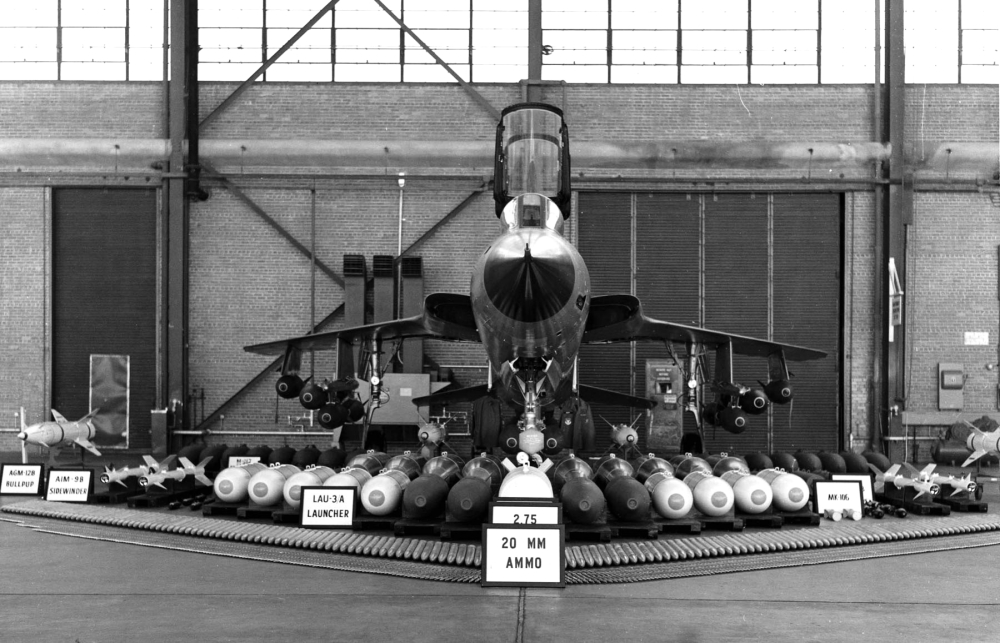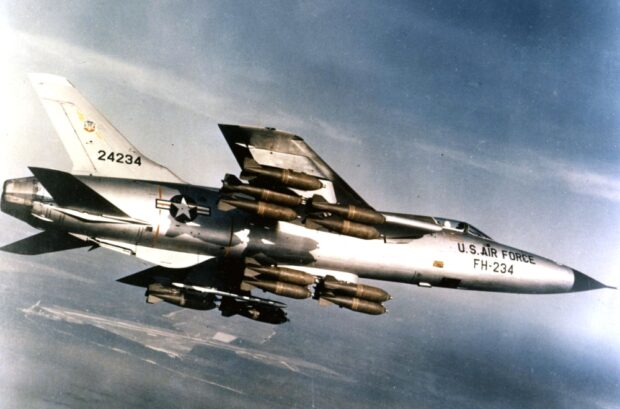The F-105 Thunderchief is an American supersonic fighter-bomber that served with the United States Air Force from 1958 to 1984. Capable of Mach 2, it conducted the majority of strike bombing missions during the early years of the Vietnam War; it was the only American aircraft to have been removed from combat due to high loss rates.
It was originally designed as a single-seat, nuclear-attack aircraft; a two-seat Wild Weasel version was later developed for the specialized Suppression of Enemy Air Defenses (SEAD) role against surface-to-air missile sites. The F-105 was commonly known as the “Thud” by its crews.
As a follow-on to the Mach 1 capable North American F-100 Super Sabre, the F-105 was also armed with missiles and a rotary cannon; however, its design was tailored to high-speed low-altitude penetration carrying a single nuclear weapon internally. First flown in 1955, the Thunderchief entered service in 1958. The single-engine F-105 could deliver a bomb load greater than some American heavy bombers of World War II such as the Boeing B-17 Flying Fortress and Consolidated B-24 Liberator.
The F-105 was one of the primary attack aircraft of the Vietnam War; over 20,000 Thunderchief sorties were flown, with 382 aircraft lost including 62 operational (non-combat) losses (out of the 833 produced). Although less agile than smaller MiG fighters, USAF F-105s were credited with 27.5 kills.
During the war, the single-seat F-105D was the primary aircraft delivering heavy bomb loads against the various military targets. Meanwhile, the two-seat F-105F and F-105G Wild Weasel variants became the first dedicated SEAD platforms, fighting against the Soviet-built S-75 Dvina (NATO reporting name: SA-2 Guideline) surface-to-air missiles.
Two Wild Weasel pilots were awarded the Medal of Honor for attacking North Vietnamese surface-to-air missile sites, with one shooting down two MiG-17s the same day. The dangerous missions often required them to be the “first in, last out”, suppressing enemy air defenses while strike aircraft accomplished their missions and then left the area.
When the Thunderchief entered service it was the largest single-seat, single-engine combat aircraft in history, weighing approximately 50,000 pounds (23,000 kg). It could exceed the speed of sound at sea level and reach Mach 2 at high altitude. The F-105 could carry up to 14,000 lb (6,400 kg) of bombs and missiles. The Thunderchief was later replaced as a strike aircraft over North Vietnam by both the McDonnell Douglas F-4 Phantom II and the swing-wing General Dynamics F-111 Aardvark.
General characteristics
Crew: 1 (F-105F: 2)
Length: 64 ft 4+3⁄4 in (19.628 m)
Wingspan: 34 ft 11+1⁄4 in (10.649 m)
Height: 19 ft 8 in (5.99 m)
Wing area: 385 sq ft (35.8 m2)
Aspect ratio: 3.18
Airfoil: root: NACA 65A005.5; tip: NACA 65A003.7
Empty weight: 26,855 lb (12,181 kg)
Gross weight: 35,637 lb (16,165 kg)
Max takeoff weight: 52,838 lb (23,967 kg)
Fuel capacity: 770 US gal (640 imp gal; 2,900 l) in three flexible fuselage tanks + 390 US gal (320 imp gal; 1,500 l) weapon-bay tank, with provision for 1x 650 US gal (540 imp gal; 2,500 l) or 750 US gal (620 imp gal; 2,800 l) centerline drop tank and 2x 450 US gal (370 imp gal; 1,700 l) underwing drop tanks; Total maximum fuel 2,810 US gal (2,340 imp gal; 10,600 l)
Zero-lift drag coefficient: CD 0.0173
Drag area: 6.65 sq ft (0.6 m2)
Powerplant: 1 × Pratt & Whitney J75-P-19W afterburning turbojet engine, 14,300 lbf (64 kN) thrust 26,500 lbf (117.88 kN) with afterburning and water injection
Performance
Maximum speed: 1,210 kn (1,390 mph, 2,240 km/h) / Mach 2.1 at 35,000 ft (10,668 m)
Combat range: 676 nmi (778 mi, 1,252 km)
Ferry range: 1,917 nmi (2,206 mi, 3,550 km)
Service ceiling: 48,500 ft (14,800 m)
Rate of climb: 38,500 ft/min (196 m/s)
Time to altitude: 35,000 ft (10,668 m) in 1 minute 42 seconds
Lift-to-drag: 10.4
Wing loading: 93 lb/sq ft (450 kg/m2)
Thrust/weight: 0.74
Armament
Guns: 1 × 20 mm (0.787 in) M61A1 Vulcan 6-barreled Gatling cannon, 1,028 rounds
Hardpoints: 5 total: 4 × under-wing, 1 × centerline pylon stations plus an internal bomb bay with a capacity of up to 14,000 lb (6,400 kg) of ordnance, with provisions to carry combinations of:
Rockets:
LAU-32/LAU-59 rocket pods with 7 x FFARs each
Missiles:
AIM-9 Sidewinder air-to-air missiles
AGM-12 Bullpup air-to-surface missiles
AGM-45 Shrike anti-radiation missiles
Bombs:
M117 and Mark 80 series of general-purpose bombs
M118 demolition bombs
Nuclear weapons B28, B43 stored internally and B57, B61
Cluster munitions of various types, including CBU-24

F-105F with armament layout in August 1964; including 20 mm (0.79 in) cannon rounds, 2.75 in (70 mm) rockets, Bullpup and Sidewinder missiles, general-purpose bomb, cluster bombs, LAU-3A Launchers, flare and chaff dispensers and drop tanks
Avionics
NASARR R-14A radar
AN/ASG-19 Thunderstick fire control system
AN/ARN-85 LORAN (AN/ARN-92 in Thunderstick II-modified aircraft)
Top Photo: Republic F-105D-30-RE Thunderchief (SN 62-4234) in flight with a full bomb load of M117 750 lb bombs. Normally drop tanks were carried on the inboard wing pylons.
Sources: Wikipedia; YouTube

